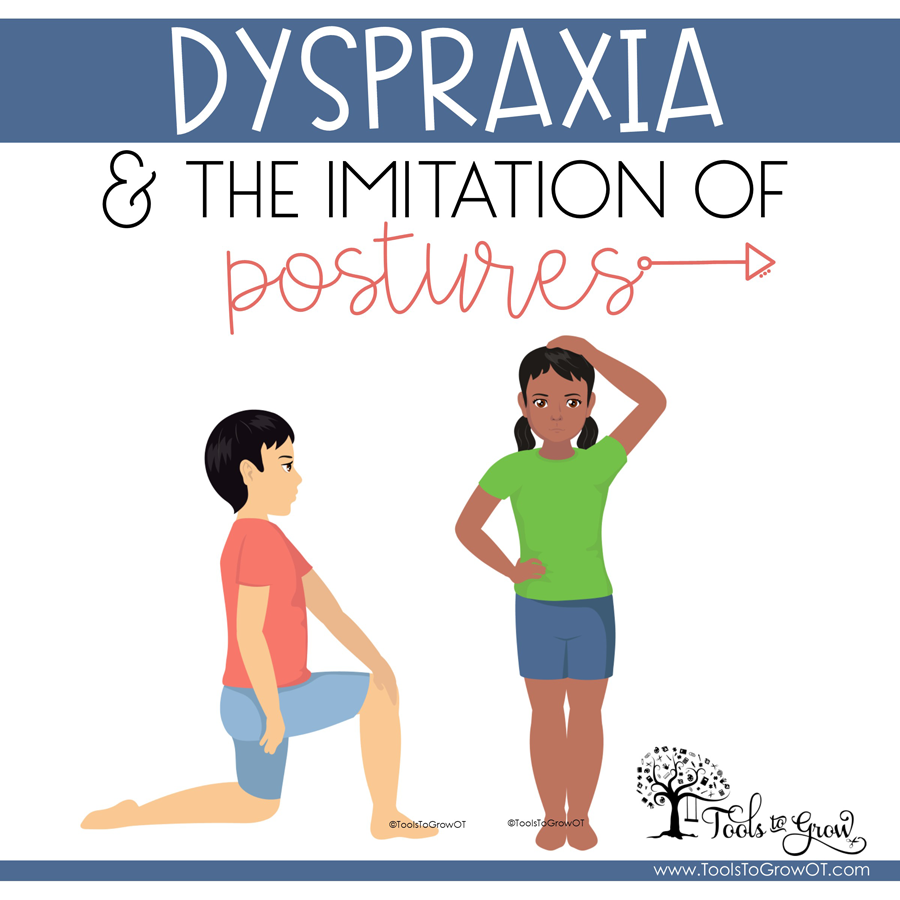Dyspraxia and the Imitation of Postures
04.28.2019
Pediatric therapists know that praxis is a broad term that involves a child’s ability to conceptualize, organize, and direct unfamiliar purposeful actions. Praxis has been described as a bridge between cognition and action. Praxis allows children to plan and execute motor skills in a refined and efficient manner, thereby allowing for ideal fulfillment of a child’s life roles.

Intact praxis includes these parts:
- Ideation: forming a goal for action based upon the child’s environment. This part relies heavily on cognition. For example, the child forms the goal to climb to the top of the stairs to get his toy.
- Motor Planning: figuring out how to accomplish the climb. This requires problem solving, body awareness, and sequencing of actions. This part relies heavily upon a child’s sensory processing.
- Execution: carrying out the plan or doing the activity. In addition to ideation and motor planning, the execution of the activity also requires motor coordination.
Dyspraxia has been described as a disorder in processing sensory information and using it to program motor actions. A child with problems with praxis may struggle to learn new motor tasks, and then generalize that learning into new settings. In young children, a lack of flexibility and creativity are strong indicators of dyspraxia. Young children constantly encounter new situations that require praxis, those with excellent praxis will be the most inventive in their living and play environments.
A child with dyspraxia can present with dysfunction in the gross motor, fine motor, and/or oral motor areas.
In the gross motor area, such a child may look clumsy. This child will really struggle with activities that require multiple movements, those movements that require sequencing, and mastering movements that are novel. This may include riding a bike, as well as participation in sports and other playground games.
In the fine motor area, such a child may show poor coloring skills, messy handwriting, and struggle with fasteners/tying.
Other signs of dyspraxia may include:
- Delays in motor milestones such as rolling, sitting, crawling, walking and running.
- Tripping, falling, and bumping into people and objects.
- Frequently breaking objects/toys unintentionally.
- Messy eaters with decreased skill using utensils.
- Trouble with constructive manipulation such as using scissors, snap blocks, and beads. Child may have poor in-hand manipulation skills.
- Poor organization of personal space.
- Struggling with imitating postures or simple movements.
- Child may take an adult’s hand to perform the needed action(s), as if your hand will be more effective.
- Child is easily frustrated- may frequently cry, tantrum or refuse to participate.
Dyspraxia occurs in children with developmental delays, including those with autism. Children with an autistic spectrum disorder have been known to have impairments in overall imitation abilities. Many of such children have been observed to show a narrow range of motor schemes that may result in highly habitual and repetitious movements. This of course can truly restrict their ability to engage in their environment.
Imitation, one part of praxis, is important in the development of interpersonal relations. This includes empathy, sharing, and non-verbal communication. So by developing a child’s praxis, not only will there be progress in adaptive motor skills, the child’s social skills may also advance.
Because motor imitation helps children learn new motor skills, a child with deficits in praxis may have a treatment plan that includes intervention for postural praxis. Postural praxis has been defined as the imitation of unfamiliar static postures.

To address this need, Tools To Grow is pleased to offer: COPY ME! Body Position Posters and Cards!
Therapists may use these illustrated resources that depict 42 different body positions. The postures range in complexity from the simple to imitate with symmetrical limb positioning, to the advanced asymmetrical cross body limb postures. Some advanced postures required single limb balance. All will challenge a child to develop his/her body scheme awareness.

We are pleased to present two different versions of “Copy Me! Body Position Resources:
(1) Posters: One Full-Sized Illustrated Image Per Page
- Color Version
- Black/White (Ink Friendly Version)
(2) Cards: Two Illustrated Images Per Page
- Color Version
- Black/White (Ink Friendly Version)

Tools to Grow is also pleased to offer Pediatric Yoga Cards. These Yoga Cards are another tool that will help children of all abilities to develop motor imitation, postural praxis, and body awareness.

Summer is just around the corner! Find our NEW Summer Ocean Theme Yoga cards here!
Related Topics: Gross Motor, Praxis/Motor Planning , Yoga


